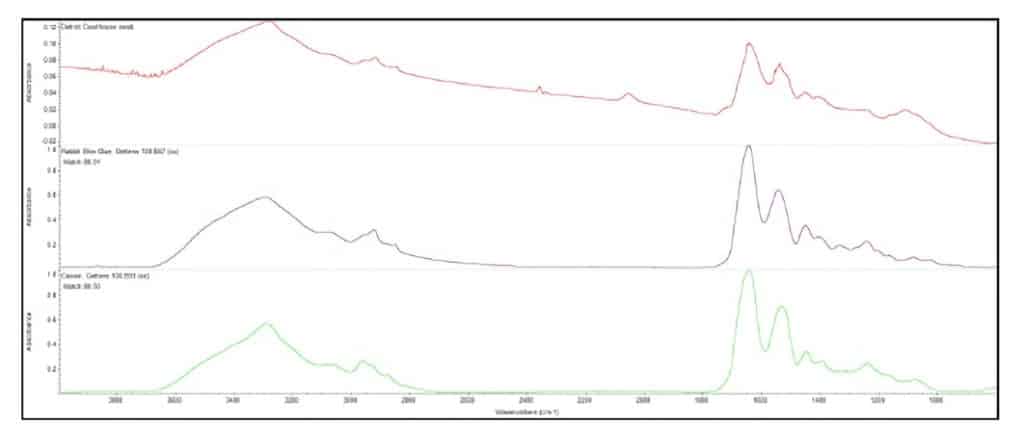Historic paint analysis
Connecticut-based restoration and conservation experts John Canning & Co looks at historic paint analysis and finishes investigation undertaken to help identify finishes in historic structures.
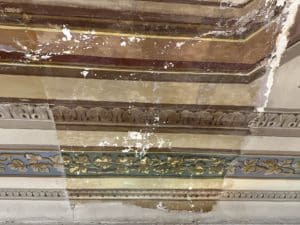
The analysis uncovers the layers of history
The analysis uncovers the layers of history, from the original paint application through all of the alterations that followed. The analysis can be performed on a variety of a historical structure’s different architectural elements (plaster, wood, metal etc.) and reveals a variety of finishes including paint, varnish, and metallic leaf. This process usually involves some archival research for historic materials, on-site investigation, scientific analysis, and the creation of a final interpretation report.
There are a number of paint analysis techniques commonly used during a historic paint analysis, which are explored in detail below to give a better understanding of the various ways in which it is possible to coax a building’s history out of the past.
Historic details revealed
Finish exposures are performed by carefully removing over-paint to reveal historic colours and patterns. This can be done mechanically and/or with chemical strippers.
Historic information that has been gathered during the archival research process of a historic paint analysis and finish investigation can assist in identifying areas for exposure. The photographs, articles, past structure reports or other information gathered during the research phase become a guide. The size of the area of exposure can vary depending on what is uncovered, what the overall plan is and how much of a decorative scheme needs to be revealed. Sometimes once a historic decorative scheme has been discovered, smaller exposures are done in other areas, to see if the same decorative schemes are found elsewhere.
This technique is best used when wanting to uncover potential hidden artwork or patterns, and will often tell the whole story of a historic decorative scheme.
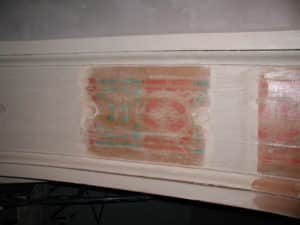
Historic paint details revealed
Optical microscopy
Optical microscopy refers to the visual inspection of a collected paint sample under a variety of magnifications. It allows for the detection of the various pigment grain sizes, and also provides a visual of the layers of paint and finishes from the sample.
Optical microscopy is a standard analysis that provides a good base understanding of the layers of paint, varnish and any other build-ups that have occurred through the years. That being said, it might not make the identification of fine details possible, and for that reason is often paired with other forms of analysis.
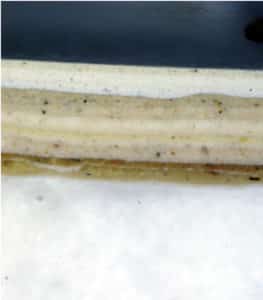
Optical microscopy allows for the detection of the various pigment grain sizes
Fluorescent microscopy
One of the most common techniques used in a finishes investigation of paint analysis is fluorescent microscopy, as fluorescent microscopes are standard equipment and can provide very useful information.
Fluorescent microscopy allows the examination of autofluorescence of individual paint layers. Using ultraviolet light and filters, cross-section samples can be examined to reveal and distinguish the layers. Different materials have characteristics that react uniquely to ultraviolet light, which in turn allows for easier identification of layers in stratigraphies and the history of the paint sample than the standard optical microscopy.

Fluorescent microscopy is one of the most common techniques used
Polarised light microscopy
Polarised light microscopy (PLM) is another common technique used when it is necessary to identify pigments. It involves analysing very small paint chip samples of finish layers (right down to and including the substrate, so nothing is missed) and examining the cross-sections for colours and material characterisation.
PLM is best used to help determine the paint colours, architectural finishes, and to show finish stratigraphies under different kinds of light and reveal the presence of different materials for the existing layers.
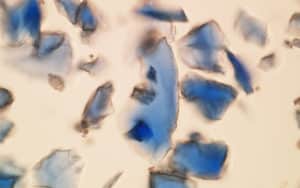
Polarized light microscopy is another common technique used when identifying pigments is necessary 2017-12-18T20:08:48Z
Fourier Transform Infrared Spectrometry (FTIR)
Infrared spectrometry is useful for the identification of both organic and inorganic compounds. FTIR is used to determine the type of paint (chemicals, pigments, etc.) by analysing the way in which its various components absorb infrared light.
The FTIR technique is useful for analysing the chemical composition of smaller particles as well as larger areas on the surface. It can be best used for the analysis of materials to aid in the choice of the optimum solvent needed to selectively remove certain coatings whilst leaving others unaffected.
Knowing when to contact a professional
When it comes to conducting a historic paint analysis of finishes investigation, most professionals will use a combination of techniques in order to identify finishes as precisely as possible.
Though in some cases a simpler analysis may be sufficient, a more comprehensive analysis can be useful when knowing the composition of the paint is necessary to identify the cause of failures, or when it is necessary to determine the best cleaning agents for historic preservation and conservation purposes so that original decoration does not get destroyed.
FTIR is used to determine the type of paint
Recent project
A recent project completed by John Canning & Co is the Basilica of the Sacred Heart of Jesus in Pennsylvania, which involved many of the techniques described above. “It is a recent example of the largest paint exposure our firm has encountered, revealing all the decorative paint and fine art designs of the original chapel,” explains Yvette Dudac, Director of Business Development at John Canning & Co. “The scale of the well-preserved original decoration is truly a unique find in the preservation industry.”
Founded in 1730, the originally-named Conewago Chapel began as a log cabin-styled building established by the arrival of early English Jesuits in 1741 to the Conewago region of Pennsylvania. It was soon to be named St Mary of the Assumption. From 1785-1787, a new church was built to welcome the increased volume of worshipping members to the Conewago congregation. Under this new construction, the church was dedicated to the Sacred Heart of Jesus, and was the first Western Hemisphere parish to bear this honour. To date, the Conewago Chapel is the oldest Catholic church made of stone construction in the US. Pope St John XXIII decreed the Church of the Sacred Heart of Jesus in Hanover, PA a minor basilica in 1962, formally acknowledging the historic, artistic, and pastoral renown of Conewago.
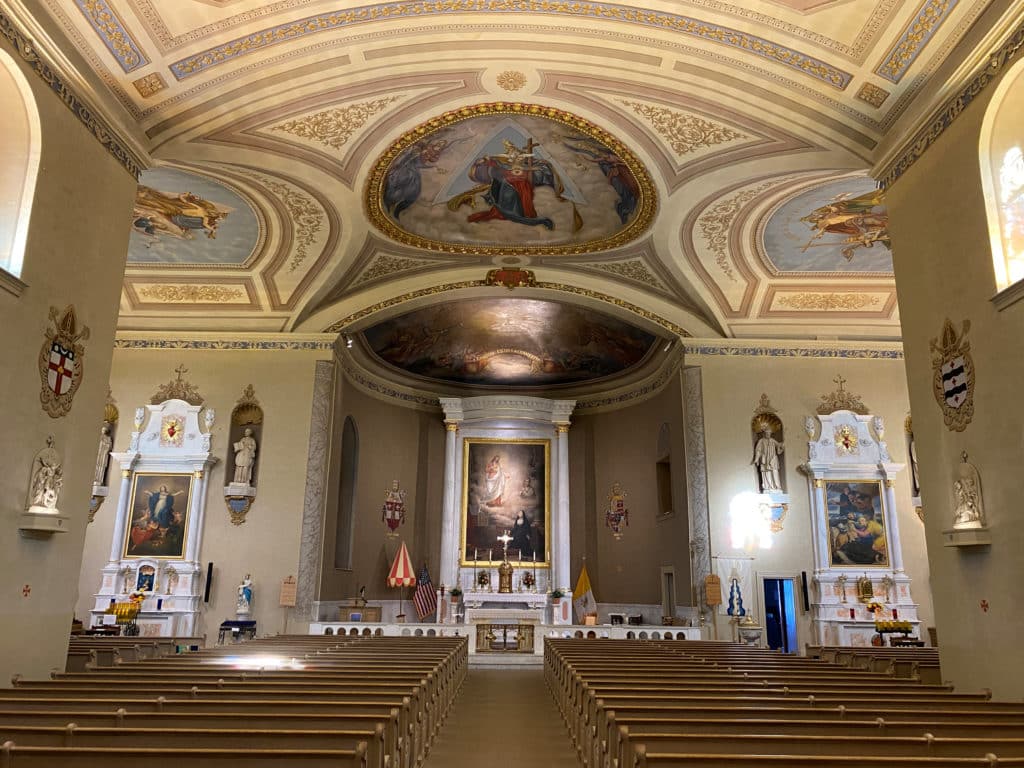
The Basilica of the Sacred Heart of Jesus in Pennsylvania before restoration
Work scope
Completed within a year, the scope of work performed by Canning focused on the historic decorative paint and fine art conservation of the Basilica of the Sacred Heart of Jesus. Upon completion of the initial paint investigation, Canning shared findings with Father Dwight Schlaline, revealing that the Basilica had well-preserved original paint designs beneath the existing decorative paint layers. This amazing discovery led to the largest paint exposure the company has ever encountered, revealing all decorative paint and fine art designs of the original chapel. The scale of well-preserved original decoration is truly a unique find in the preservation industry.
Some of the key project areas of mention are the Sacred Heart sanctuary ceiling, Assumption of Mary nave ceiling, original Conewago Chapel artist Franz Stecher’s representation of the Trinity nave ceiling, and the North and South transepts featuring the Nativity of Our Lord, Incarnation of Our Lord, and Salvation of Jesus Christ.
If you are unsure about the steps you should be taking and what the best techniques are to use for your historic paint analysis is, it is best to consult a conservator, such as John Canning & Co, which has decades of experience in paint analysis.

The Basilica of the Sacred Heart of Jesus in Pennsylvania after restoration


